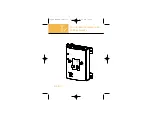
(y
1
(x),x)-
(y6(x),x)|x=x2-h
returns 3.7629E-8
(y2(x),x)-
(y6(x),x)|x=x2+h
returns 7.446E-9
The errors seem small enough, but calculating the derivatives correctly (as shown below) gives the
true errors:
(y
1
(x0),x0)-k*
(polyEval(spl4,x),x)|x=-
1
and x0=x2-h
returns
-6.087E-
11
(y2(x0),x0)-k*
(polyEval(spl4,x),x)|x=
1
and x0=x2+h
returns
3.60
1
E-
11
So far, the splice seems to work well. As a final check, we graph the splice function over the splice
interval. In the Y= editor, use [F4] to select y4, y5 and y7. Because f
1
(x), f
2
(x) and the splice function
are all so close together, plotting these error functions gives a better picture of the splice fit. To set the
x-axis range, press [WINDOW] and set xmin to x2-h, and xmax to x2+h. Press [F2] [A] to plot the
splice, which results in this graph:
The two solid traces are f
1
(x) and f
2
(x), relative to sin(x), and the dotted trace is the splice function,
relative to sin(x). Note that the splice slope appears to match f
1
and f
2
at the endpoints, and it passes
through x
2
, as we specified. Based on the numerical check results, and the plotted result, it appears
that we have a splice that we can use. (Note: to get the dotted trace, I set the plot Style for y7 to Dot,
and the plot resolution to 2).
However, the splice is less than f
1
and f
2
over the entire range. Assuming that f
1
and f
2
accurately
model the sin() function, we may prefer that the splice be above the two functions over the splice
interval. This is accomplished by changing the value of y2. One reasonable value is the average of the
values of f
1
(x
1
), f
1
(x
2
) and f
2
(x
3
). This is easily calculated with
mean({y
1
(x2-h),y
1
(x2),y2(x2+h})
→
yy2
We find and save the splice coefficients as before with
math\splice4(yy
1
,yy2,yy3,yd
1
,yd2)
→
spl4
and the splice now looks like this:
6 - 100
Summary of Contents for TI-92+
Page 52: ...Component side of PCB GraphLink I O connector detail 1 41...
Page 53: ...LCD connector detail PCB switch side 1 42...
Page 54: ...Key pad sheet contact side Key pad sheet key side 1 43...
Page 55: ...Key cap detail 1 44...
Page 57: ...Component side of PCB with shield removed A detail view of the intergrated circuits 1 46...
Page 410: ...void extensionroutine2 void Credit to Bhuvanesh Bhatt 10 4...
















































